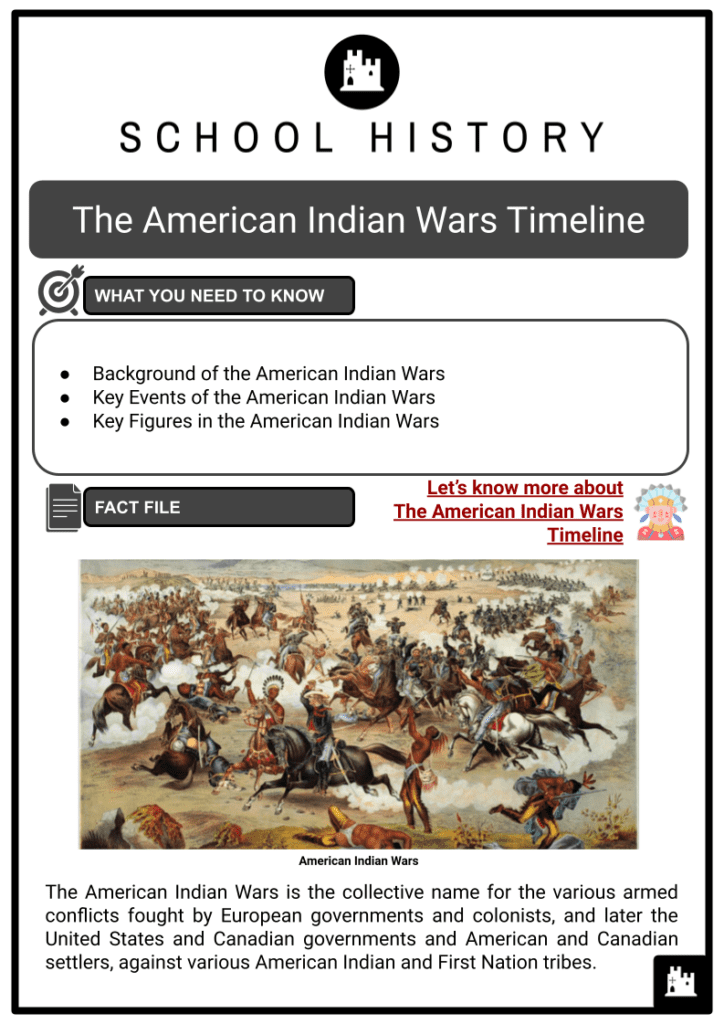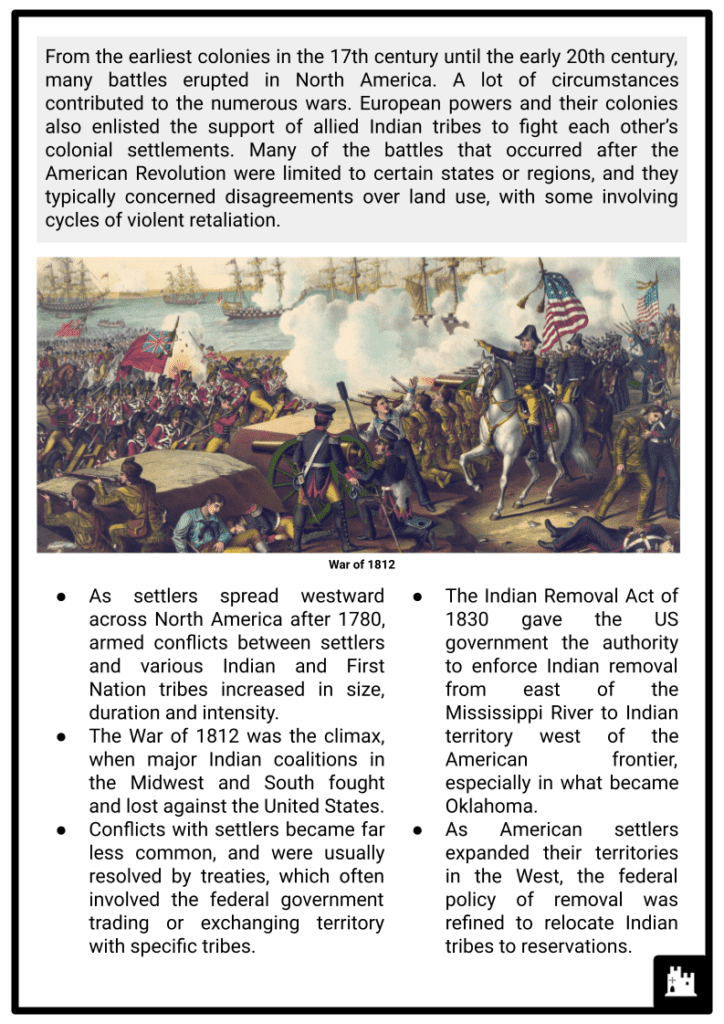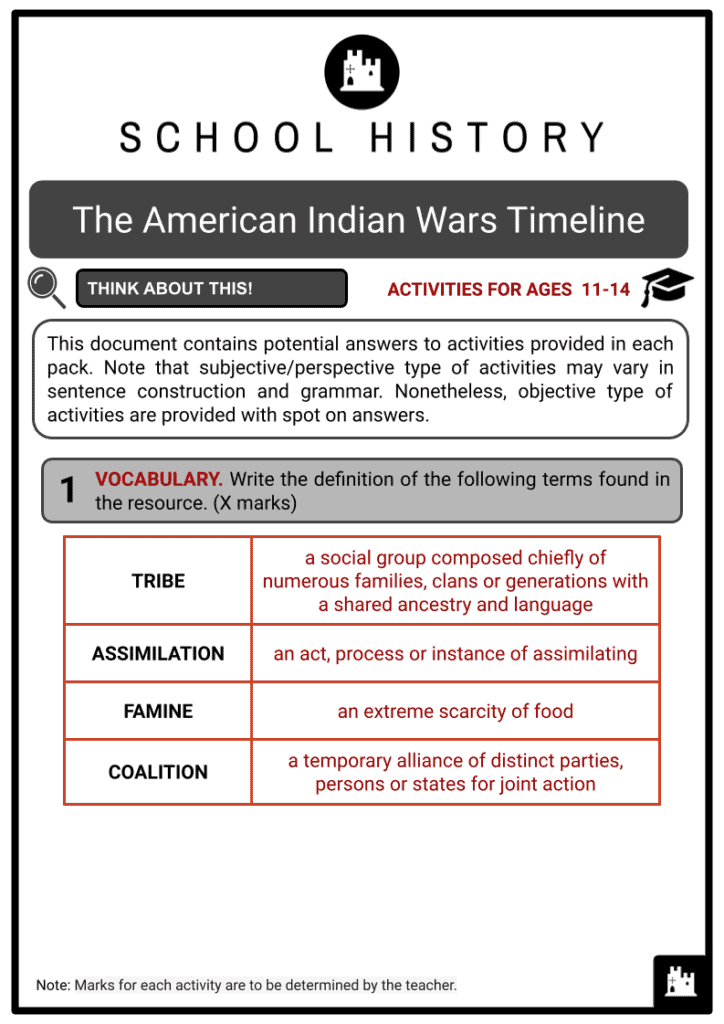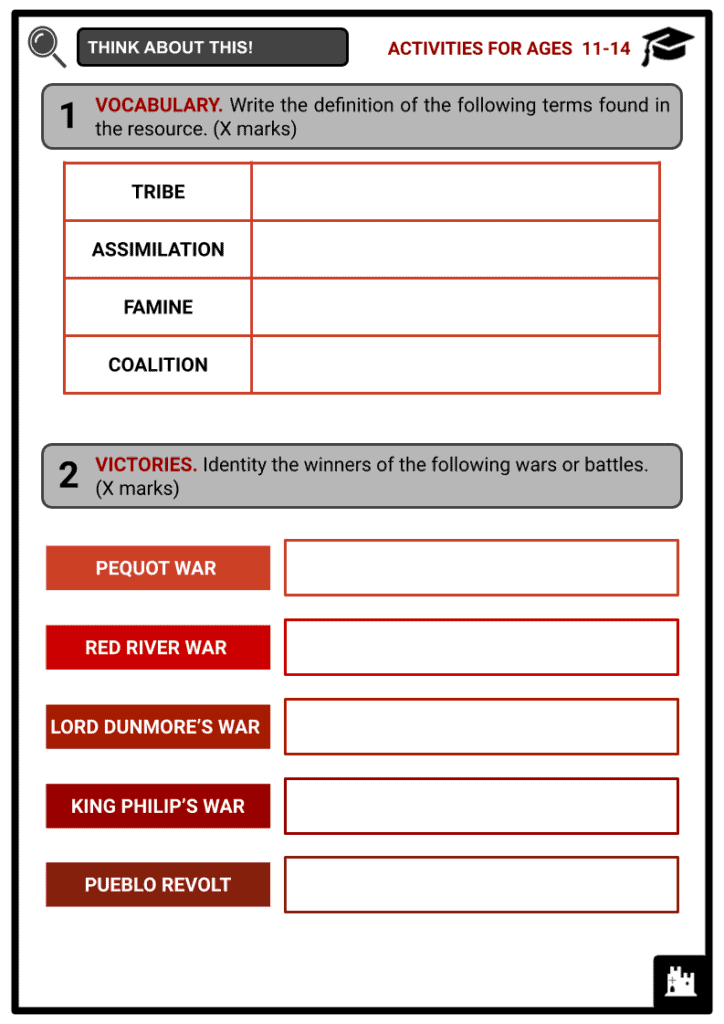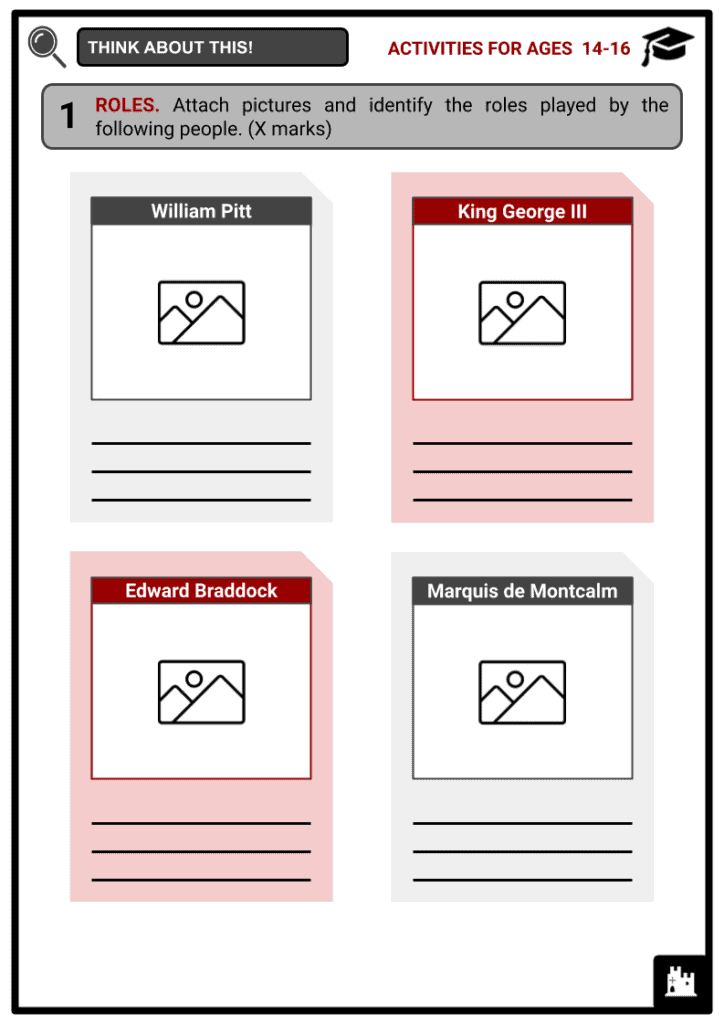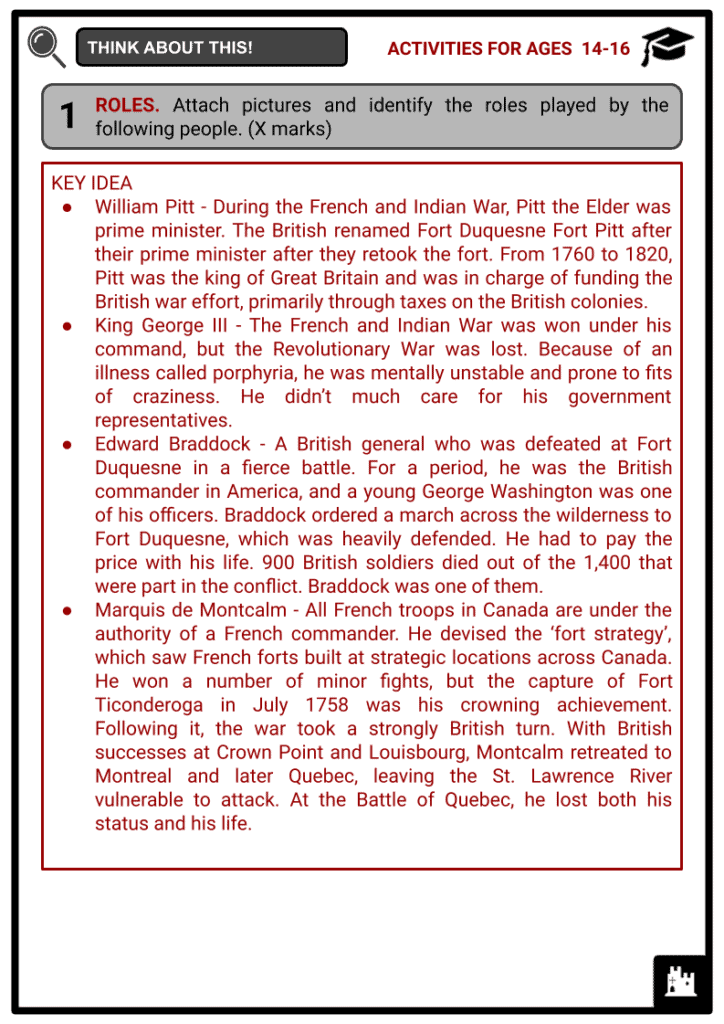Download The American Indian Wars Timeline
Do you want to save dozens of hours in time? Get your evenings and weekends back? Be able to teach The American Indian Wars Timeline to your students?
Our worksheet bundle includes a fact file and printable worksheets and student activities. Perfect for both the classroom and homeschooling!
Table of Contents
Add a header to begin generating the table of contents
Summary
- Background of the American Indian Wars
- Key Events of the American Indian Wars
- Key Figures in the American Indian Wars
Key Facts And Information
Let’s find out more about the American Indian Wars Timeline!
- The American Indian Wars is the collective name for the various armed conflicts fought by European governments and colonists, and later the United States and Canadian governments and American and Canadian settlers, against various American Indian and First Nation tribes.
- From the earliest colonies in the 17th century until the early 20th century, many battles erupted in North America. A lot of circumstances contributed to the numerous wars. European powers and their colonies also enlisted the support of allied Indian tribes to fight each other’s colonial settlements. Many of the battles that occurred after the American Revolution were limited to certain states or regions, and they typically concerned disagreements over land use, with some involving cycles of violent retaliation.
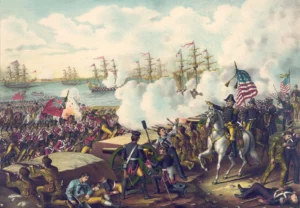
- As settlers spread westward across North America after 1780, armed conflicts between settlers and various Indian and First Nation tribes increased in size, duration and intensity.
- The War of 1812 was the climax, when major Indian coalitions in the Midwest and South fought and lost against the United States.
- Conflicts with settlers became far less common, and were usually resolved by treaties, which often involved the federal government trading or exchanging territory with specific tribes.
- The Indian Removal Act of 1830 gave the US government the authority to enforce Indian removal from east of the Mississippi River to Indian territory west of the American frontier, especially in what became Oklahoma.
- As American settlers expanded their territories in the West, the federal policy of removal was refined to relocate Indian tribes to reservations.
1622-1624 THE POWHATAN CONFEDERACY
- Also known as the Jamestown Massacre, this bloodbath gave the English government an excuse to justify their efforts to attack Indians and confiscate their land. This was a conflict between the indigenous people in Virginia and the colonists after 12 years of peaceful coexistence. The conflict left many colonists and indigenous people dead.
1637 THE PEQUOT WAR
- This conflict took place along the Thames River in present-day Connecticut and Rhode Island. Pequots were rivals of the Narragansetts and Mohegans.
- Other natives in the region were the Wampanoags, Nipmucks, Pocumtucks and Abenakis. Tensions arose over the colonists’ disdain of the natives as the former trespassed on the farming and hunting lands of the natives. Over 600 Native Indians were killed and others were sold as slaves in Bermuda.
1640-1701 THE BEAVER WARS
- This is also known as the Iroquois Wars or the French and Iroquois Wars. It was a battle between the Iroquois and their Dutch allies against the Algonquin tribes and their French allies. The war was a result of the depletion of the Beaver population, useful to the fur trade in the areas controlled by the Iroquois.
1675-1677 KING PHILIP’S WAR
- This war was named after Metacomet of the Wampanoag tribe, nicknamed Philip by the British. The Native American tribes of the Wampanoags, Narragansetts, Nipmucks, Pocumtucks and Abenakis fought the British. Up to one-third of America’s white population was wiped out. This was the final struggle by the Native Americans of Connecticut. The war ended with Metacomet’s beheading and the near decimation of the Native Americans in his coalition.
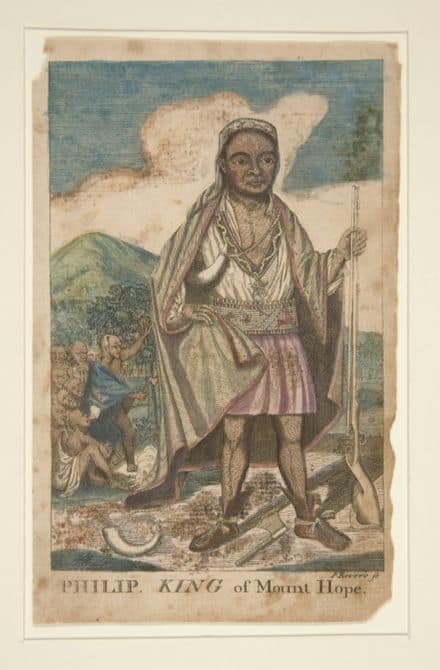
1680-1962 THE PUEBLO REVOLT
- This occurred in New Mexico and Arizona between the Tuscarora Native Americans and the Spanish under the leadership of the Popé, Pueblo. The Indians won and lived independently for 12 years until the Spanish reconquered in 1692.
1689-1762 THE FRENCH AND INDIAN WAR
- This was a war between France and Great Britain over the North America region. The Iroquois Indians were allied to the French, and the Algonquian tribes were allied to the British. The war ended with the signing of the Treaty of Paris in 1763.
1702-1713 QUEEN ANNE’S WAR
- This conflict occurred between French and English colonists and their respective Indian allies on several fronts including Spanish Florida, New England, Newfoundland and Acadia. The war ended with the Treaty of Utrecht, but the Indians were not included in peace negotiations and lost much of their land.
1711-1713 THE TUSCARORA WAR
- The Tuscarora, led by Chief Hancock, launched several attacks on settlements, killing settlers and destroying farms. In 1713, James Moore and Yamasee warriors defeated the Raiders.
1764 PONTIAC’S REBELLION
- This occurred in the Ohio Valley, owing to the harsh treatment of the natives by the British. The natives under Ottawa Chief Pontiac (1720-1769) rebelled. When a planned British retaliatory assault on Pontiac’s village was discovered, the Indians attacked and killed many British soldiers during the Battle of Bloody Run on 31 July.
1775 LORD DUNMORE’S WAR
- This war occurred in Southern Ohio over hostilities between Native Indians and the settlers and traders in the area. Lord Dunmore, the Governor of Virginia, sent 3,000 soldiers who defeated the 1,000 Native Indians.
1811-1813 TECUMSEH’S WAR
- Also called the Battle of Tippecanoe. The Prophet, brother of Shawnee chief Tecumseh, attacked Indiana territory along the Wabash and Tippecanoe Rivers but was defeated by the troops of William Henry Harrison.
1812 WAR OF 1812
- The War of 1812 begins. It was fought between Britain and the United States and their respective Indian allies. Tecumseh’s defeat at the Battle of Tippecanoe led him to support the British. At the Battle of Thames (one of many battles in the War of 1812) along the Thames River in Ontario, British troops and Tecumseh’s coalition were outnumbered and easily defeated again. Tecumseh died in the battle, leading many Indians to abandon the British cause.
1813-1814 CREEK WAR
- The Creek War erupted in Alabama and Georgia. American forces led by Andrew Jackson defeated the Creek Indians. The war ended with the signing of the Treaty of Fort Jackson and the Creeks ceding almost two million acres of land.
1813 PEORIA WAR
- This was a conflict between the US Army, settlers and the Native American tribes of the Potawatomi and the Kickapoo tribes in the Peoria area of Illinois. Their villages were attacked, and the tribes left the area. Hostilities resumed in the Winnebago War of 1827 and the Black Hawk War.
1817-1818 FIRST SEMINOLE WAR
- Erupted in the Florida Everglades area as the Seminole Indian tribe defended their lands and runaway slaves against the American Army.
1826 WINNEBAGO WAR
- This was a small conflict that occurred in Wisconsin between the settlers and lead miners, who were trespassing on their land, and the Winnebago tribe. The Winnebago War preceded the larger Black Hawk War.
1832 BLACK HAWK WAR
- This occurred in Northern Illinois and Southwestern Wisconsin. Chief Black Hawk led the Native Indian Sauk and Fox tribes in an attempt to re-take their homeland. The Department of Indian Affairs was established.
1835-1842 SECOND SEMINOLE WAR
- The Indians fought to retain their land in the Florida Everglades but were almost wiped out.
1835-1837 CREEK ALABAMA UPRISING
- Took place in Alabama and Georgia along the Chattahoochee River. It resulted in a defeat for the Creek forces and the removal of the Creek people from their native lands to the Indian territory in present-day Oklahoma.
1837 OSAGE INDIAN WARS
- After years of war with the invading Iroquois, the Osage migrated west of the Mississippi River to their historic lands in present-day Arkansas, Missouri, Kansas and Oklahoma. The conflict involved a number of skirmishes with the Osage Indians in Missouri.
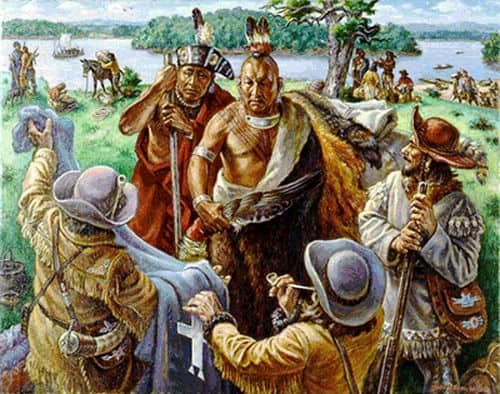
1855-1858 THIRD SEMINOLE WAR
- Still in the Florida Everglades area. The Seminole, led by Chief Billy Bowleg, made their last stand and were defeated and deported to Indian territory in Oklahoma.
1861-1900 APACHE WARS
- Fought in Arizona, New Mexico and Texas by the natives led by Geronimo and Cochise in opposition to the reservation system. Geronimo surrendered in 1886, but others carried on the fight until 1900.
1866 RED CLOUD’S WAR
- The war started when the US government built the Bozeman Trail across Indian territory in order to provide miners and settlers access to gold in Montana Territory through the Powder River. An Indian coalition led by Lakota Chief Red Cloud attacked workers, settlers and soldiers for two years in order to preserve their native grounds.
- When the US Army left the area and signed the Treaty of Fort Laramie in 1868, their persistence paid off.
1874 RED RIVER WAR
- in Northern Texas against the Arapaho, Comanche, Cheyenne and Kiowa tribes, who eventually surrendered. During the war, the US Army engaged in a number of conflicts with Southern Plains Indians who had fled their reservations to reclaim former hunting areas in the Texas Panhandle.
- The war ended when the Indians were forced to return to their reservations after severe pressure from the US Army.
1876 BATTLE OF THE ROSEBUD
- Fought in Montana by the Lakota Sioux and Cheyenne led by Chief Crazy Horse against the American soldiers under General George Crook. The natives managed to stop the reinforcement sent out to support General Custer.
1876 BATTLE OF THE LITTLE BIGHORN
- General Custer and his soldiers were massacred by the Sioux warriors on the Little Bighorn River and were wiped out in the ensuing fight. Custer and his men were all killed in the battle, known as Custer’s Last Stand. Despite the decisive Indian victory, the US government forced the Sioux to sell the Black Hills and leave the land.
1890 THE WOUNDED KNEE MASSACRE
- Fought in South Dakota following the killing of Chief Sitting Bull. Chief Big Foot led the last band of the Lakota Sioux, who were massacred by the US Army at Wounded Knee Creek.
- By the early twentieth century, the American-Indian Wars were effectively over, but it had come at a high cost. Despite the fact that Indians had assisted colonial settlers in surviving in the New World, aided Americans in gaining independence, and ceded vast amounts of land and resources to pioneers, tens of thousands of Indian and non-Indian lives were lost to war, disease and famine, and the Indian way of life was pretty much destroyed.
Image sources
- https://th-thumbnailer.cdn-si-edu.com/AgFPT7wsbg2IfblInF2zeb-sQ-Y=/fit-in/1600x0/https://tf-cmsv2-smithsonianmag-media.s3.amazonaws.com/filer/32/82/32827c55-c567-4508-ae60-8fe37b647fc6/42-24017617-1.jpg
- https://upload.wikimedia.org/wikipedia/commons/thumb/6/6c/Philip_King_of_Mount_Hope_by_Paul_Revere.jpeg/440px-Philip_King_of_Mount_Hope_by_Paul_Revere.jpeg
- https://www.legendsofamerica.com/wp-content/uploads/2018/11/FettermanMassacre-700.jpg

